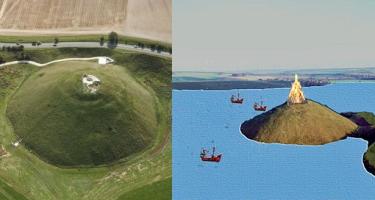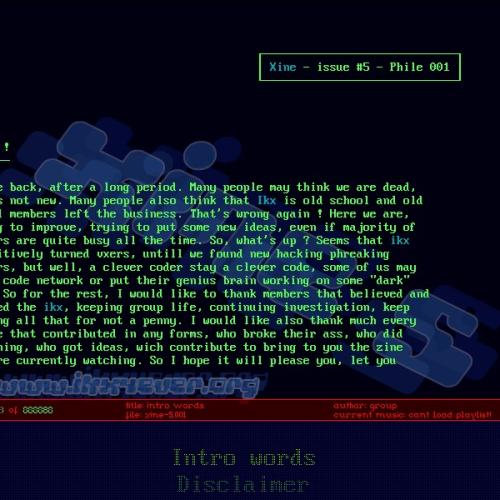Copy Link
Add to Bookmark
Report
impr9301

+++++++++++++++++++++++++++++++++++++++++++++++++++++++
IS THIS AN UNTAMPERED FILE?
This ASCII-file version of Imprimis, On Line was
packaged by Applied Foresight, Inc. (AFI hereafter).
Every AFI-packaged ASCII version of Imprimis is
distributed in an "-AV protected" ZIP file format.
"AV" is the authenticity verification feature provided
to registered PKZIP users, which Applied Foresight,
Inc., is. If you are using the MS-DOS PKUNZIP.EXE
program written by PKWARE Inc. and do not see the "-AV"
message after every file is unzipped AND receive the
message "Authentic files Verified! # JAA646 ZIP
Source: Applied Foresight Inc. (CIS 71510,1042)" when
you unzip this file then do not trust it's integrity.
If your version of PKUNZIP is not the PKWARE-authored
program (for instance, you are running a non-MS-DOS
version), then this message may not be displayed.
Trust only genuine AFI-packaged archives ... anything
else may be just that: ANYTHING ELSE.
+++++++++++++++++++++++++++++++++++++++++++++++++++++++
Imprimis, On Line -- January, 1993
Imprimis, meaning "in the first place," is a free
monthly publication of Hillsdale College (circulation
428,000 worldwide). Hillsdale College is a liberal arts
institution known for its defense of free market
principles and Western culture and its nearly 150-year
refusal to accept federal funds. Imprimis publishes
lectures by such well-known figures as Ronald Reagan,
Jeane Kirkpatrick, Tom Wolfe, Charlton Heston, and many
more. Permission to reprint is hereby granted, provided
credit is given to Hillsdale College. Copyright 1992.
For more information on free print subscriptions or
back issues, call 1-800-437-2268, or 1-517-439-1524,
ext. 2319.
------------------------------
"But Is It Art?"
by Arianna Stassinopoulos Huffington
Author, Picasso: Creator and Destroyer
------------------------------
Volume 22, Number 1
Hillsdale College, Hillsdale, Michigan 49242
January 1993
------------------------------
Preview: It's an old adage that if you want to gauge
the health of a nation like America, you must look
beyond its political power and its economic resources
to its culture.
Art is one of the most powerful and moving forms
of culture we know. But in looking at the art world
today, what we see all too often is merely cynicism,
nihilism and exploitation.
"Is this really art? Is there no connection
between art and morality?"--these are the kind of
questions we are asking with increasing frequency. This
Imprimis issue addresses them in no uncertain terms.
Mrs. Huffington's remarks were delivered during
Hillsdale's Center for Constructive Alternatives
seminar, "Culture Wars" in March 1992.
------------------------------
In the fall of 1989, 14 photographs by Robert
Mapplethorpe were sold at auction at Christie's for
$129,690. In the same week, 23 Mapplethorpe photographs
were sold at auction at Sotheby's for $396,275. Art
dealers were furiously bidding against each other for
photographs of leather-clad men and cropped close-ups
of an "obscene" nature. Once more, hype is confused
with art in the "bazaar of the bizarre" that our
culture has become.
At the height of the controversy surrounding
Mapplethorpe's photographs, the Whitney museum took a
full-page ad in the New York Times to protest the
cancellation of a Mapplethorpe show by the Corcoran
Gallery in Washington. "Are you going to let politics
kill art?" the ad asked in block letters. A
Mapplethorpe photograph of a tulip was used for
illustration.
Of course the trustees of the Whitney knew as well
as the rest of us that Mapplethorpe's fame and his one-
man shows at the Whitney and other venerable
institutions around the country were not based on his
photographs of flowers. But the trustees also knew that
the ad would have been self-defeating in terms of
garnering public support if it were illustrated by one
of Mapplethorpe's photographs celebrating
sadomasochism, which Mapplethorpe, in a farewell
interview before he died of AIDS, described as sex and
magic.
Yet it was precisely these photographs of torture
and degradation that put Robert Mapplethorpe on the
map, otherwise known as "the cutting edge" of art--what
our culture decides is worth exhibiting, reviewing and
talking about. If art is in danger of being killed, as
the Whitney ad implies, it is our culture, not
politics, that is the culprit. In fact, Congress is not
the right forum for this particular debate. The larger
issue is not what art is supported by public funds, but
what art is encouraged and rewarded by our culture.
At the moment, art that deals with rage, violence,
disgust and brutality rises to the top. The message
from the art world is clear: life is rotten, human
beings are rotten, love is rotten, society is rotten.
Art that may show the darkness but also gives us a
glimpse of the light beyond is seen as too "soft," too
unrealistic.
What Tom Wolfe said in The Painted Word is even
more valid today: "If a work or a new style disturbed
you, it was probably good work. If you hated it, it was
probably great....To be against what is new is not to
be modern. Not to be modern is to write yourself out of
the scene. Not to be in the scene is to be nowhere." As
a result, the art world has for years now been stuck in
the very modern and very adolescent stage of rebellion.
There is another world--of light, spirit, harmony
and truth that seems foreign to our contemporary
culture. Schumann said in the 19th century, "To send
light into the darkness of men's hearts--such is the
duty of the artist." He would be hard put to find many
such artists thriving today.
In all the huffing and puffing and booming of art
that celebrates darkness and inhumanity the same note
is struck: how powerful the work, how exquisite the
technique! The fact that adding elegance to brutality
only helps to desensitize us to its reality is glossed
over. And our response has nothing to do with defending
our civil rights and a lot to do with losing our
capacity to be shocked.
There have been great photographers who have
captured strong images of violence and cruelty
intending to shock us, often to shock us into action--
such as Jacob Riis with his pictures of New York slums,
or Lewis Hines with his pictures of children working in
coal mines.
But when we detach ourselves from the brutality
and admire the technique, we are conceding that human
beings are inert things to whom you can do anything--
sometimes in the name of art, sometimes in the name of
sexual kicks, sometimes in the name of the state. It is
a concession we cannot afford to make--the first step
on the road to Auschwitz and the Gulag Archipelago.
Discussing the arts controversy on "Phil Donahue"
two years ago, I told Tim Rollins, a young artist on
the panel who works in the South Bronx helping children
transmute violence into art, that Robert Mapplethorpe
might have benefited greatly from working with him. He
replied that Mapplethorpe's violence was between
consenting adults. I asked him if he also thought that
the consent of his followers in Jonestown exonerated
the Rev. Jim Jones.
"Jim Jones," he answered, "was not an artist."
This is a succinct expression of the feeling prevalent
in our culture that there is one moral standard for
ordinary mortals and another for artists.
"Just pronounce the magic word, 'art,' and
everything is OK," wrote George Orwell 45 years ago in
an essay on Salvador Dali. "So long as you can paint
well enough to pass the test, all shall be forgiven
you." And then he made the ultimate pronouncement not
only on Dali but on the whole debate on art and
morality:
"One ought to be able to hold in one's head
simultaneously the two facts that Dali is a good
draftsman and a disgusting human being. The one does
not invalidate, or, in a sense, affect the other. The
first thing that we demand of a wall is that it shall
stand up. If it stands up it is a good wall, and the
question of what purpose it serves is inseparable from
that. And yet even the best wall in the world deserves
to be pulled down if it surrounds a concentration camp.
In the same way it should be possible to say, 'This is
a good book or a good picture, and it ought to be
burned by the public hangman.' Unless one can say that,
at least in imagination, one is shirking the
implications of the fact that an artist is also a
citizen and a human being."
Our culture would do well to take Orwell's words
to heart. The rest of us have a duty to distinguish
constantly between the true and the false. And perhaps
to follow the example of the small boy in the fairy
tale who had the courage to cry out that the emperor
wore no clothes.
Our secular culture is finding it increasingly
hard to satisfy on a purely aesthetic diet the
spiritual instinct in us that longs for a larger
meaning. With an almost pathetic desperation, we
overestimate the significance of everything "artistic,"
including Andy Warhol's cookie jars, with ever-
diminishing emotional returns. But aestheticism--the
notion that all of existence can be sanctified as an
aesthetic phenomenon-- is exhausted. Its champions,
still dominating the art world while fighting off a
nasty case of existential dread, have failed to
recognize that it is the connection between the
aesthetic and the ethical that gives art its dignity,
its meaning, and its power. It is not an explicit
socio-realistic connection made by the artist, but a
connection made within ourselves when art pierces
through all the crusts of our narrow interests and
preoccupations and liberates the truth and the vision
of wholeness we carry within us.
------------------------------
Arianna Stassinopoulos Huffington is a writer, lecturer
and broadcaster. Born in Greece, she was educated at
Cambridge and there became president of the famed
debating society, the Cambridge Union. She has appeared
on numerous television programs in the U.S. and Great
Britain, including a series she recently hosted, "From
the Heart." Her many books include The Female Woman
(translated into 11 languages, 1974), After Reason
(1978), Maria: Beyond the Callas Legend (1981), The
Gods of Greece (1984), and one of the most talked-about
biographies of recent years, Picasso: Creator and
Destroyer (1988). Her next book, The Fourth Instinct,
will be published shortly by Simon and Schuster.
###
+++++++++++++++++++++++++++++++++++++++++++++++++++++++
End of this issue of Imprimis, On Line; Information
about the electronic publisher, Applied Foresight,
Inc., is in the file, IMPR_BY.TXT
+++++++++++++++++++++++++++++++++++++++++++++++++++++++





















